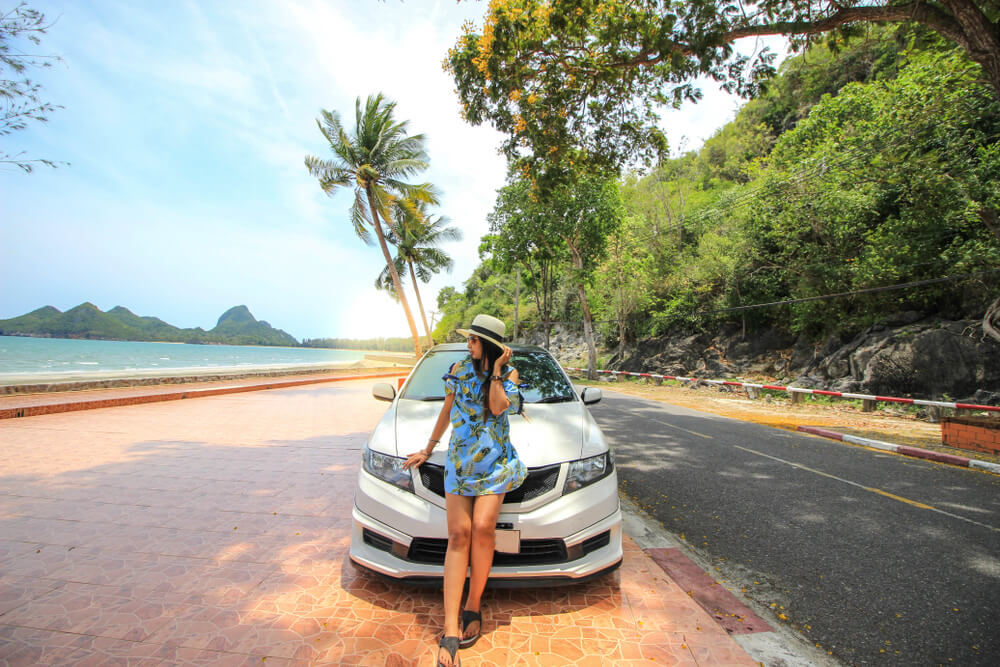Navigating the roads in Thailand demands that overseas travellers carry an International Driving Permit (IDP) and their domestic driving licence. This information is valuable to those intending to hire a car and journey securely on Thai roads.
While hiring a vehicle, it is mandatory to showcase your IDP, along with your home country’s driver’s licence. Always fasten seat belts, respect speed limitations, adhere to traffic lights and signals, and refrain from operating the vehicle under any influence to maintain traffic safety.
It is important to note that Thailand enforces unique rules for driving licenses. Visitors might additionally need a Thai driving license or a temporary permit for extended stays or if hailing from non-ASEAN nations.
Car rental firms will request a work permit or health certificate if required.
Acquainting oneself with the local traffic rules is crucial – such as yielding appropriately and recognising pedestrian crossings regulations. In the case of accidents, understand the protocol to report them correctly as part of car safety measures.
Lastly, ensure you meticulously examine your rental agreement stipulations before signing it – this includes insurance protection against personal injury and damages.
Legal Requirements for Driving in Thailand
To drive in Thailand, you must have a valid international driving permit, a Thai driving license, or a national car operator’s credential if you’re from an ASEAN country.
Valid international driving permit (IDP)
Foreigners need an International Driving Permit (IDP) and their home country license to drive in Thailand. The IDP aligns with the Vienna Convention on Road Traffic standards. You can get an IDP in your country before coming to Thailand.
It makes your license understandable in multiple languages for Thai authorities. Always carry both your IDP and domestic license while driving.
If you plan to stay longer, consider getting a Thai driving license.
Thai driving licence options
To drive in Thailand for more than 90 days, you need a Thai driving licence. This involves passing practical and theory exams about road safety and local traffic laws. You must show a medical certificate and proof of residency, like a work permit or visa.
You also need a photo taken at the Transport Office. This process ensures familiarity with Thai roads.
Short-term visitors under 90 days can use an international driving permit alongside their home country’s licence. For longer stays, obtaining a Thai driving licence is beneficial. It simplifies tasks such as car rental and dealing with local authorities.
Key Driving Rules and Regulations
In Thailand, drivers must follow speed limits and avoid driving under the influence. They should also not use phones unless through a hands-free device.
Speed limits
Speed limits in Thailand change based on location. City roads have a 60 km/h limit. Motorways allow up to 120 km/h. Always check for speed limit signs to avoid fines.
Near schools during school hours, speeds must be lower. Slow down in these areas for safety.
Drink-driving laws
Thailand enforces tough measures on drunk driving. Police action for driving under the influence can lead to heavy fines or jail time. The limit for blood alcohol content is low, implying even minimal alcohol consumption could exceed legal levels.
It’s safest to refrain from drinking when driving.
Focusing next on mobile phone use, it poses risks and legal issues while driving in Thailand.
Mobile phone usage while driving
Using a mobile phone while driving in Thailand is illegal. Drivers can face fines for holding their phones. This law helps keep roads safe and reduces accidents caused by distractions.
It is important to use hands-free devices if you need to talk or use navigation apps. Always stay focused on the road, as this ensures your safety and the safety of those around you.
Understanding traffic signals also plays a key role in driving safely in Thailand.

Renting a Car in Thailand
Renting a car in Thailand is easy, but you need the right documents. Bring your international driving permit and a valid passport when you go to rent.
Necessary documents
To rent a car in Thailand, you need several documents. First, have a valid International Driving Permit (IDP) and your home country driver’s license. You must also carry your passport and an ID card from your home country.
If you are not a resident and plan to stay longer than 90 days, get a Thai driving license as well. Most rental companies require drivers to be at least 21 years old with a category B driving license held for at least one year.
Always check the specific requirements of the rental agency before you go.
Insurance requirements
Car rental companies in Thailand require insurance. It is a must-have for any driver. Basic coverage often comes with the vehicle rental. This typically includes liability for damages to other people or property.
Additional coverage may protect you if your car gets damaged or stolen.
Drivers should check their own car insurance policies too. Some foreign policies cover international driving. It’s smart to note that many agencies offer extra insurance options.
Always review these before making a choice, as they can vary by company and policy type.
Tips for Driving Safely in Thailand
Driving in Thailand can be tricky. Watch for road signs and traffic signals. They guide you on the right path. Keep an eye out for other drivers, too. They may not follow rules as strictly as you expect.
Always wear your seatbelt; it keeps you safe.
Be ready to deal with heavy traffic, especially in cities. Stay calm and patient behind the wheel. Know who has the right of way at intersections to avoid accidents. Drive defensively and stay alert for pedestrians, cyclists, and motorbikes sharing the road with you.
Understanding road signs
Road signs in Thailand give important information to drivers. They help you know speed limits, directions, and rules. Common signs include those for stopping, yielding the right of way, and warning about hazards.
Understanding these signs is key for safe driving.
Speed limits vary across different areas. Always pay attention to the posted signs to avoid fines. Look out for traffic signals too; they guide how you should move through junctions.
Knowing these basics can help prevent accidents while renting a car or self-driving in Thailand.
Dealing with traffic and local driving styles
Traffic in Thailand can be busy. Drivers often do not follow the rules strictly. Many scooters and motorcycles weave between cars. This can make driving feel chaotic for newcomers.
Always stay alert and keep a safe distance from other vehicles.
Local drivers may be more aggressive than what you are used to. They might overtake without warning or stop suddenly. Use your mirrors and signal before making any moves. Speed limits are important, but not always followed.
Adapting to these local driving styles will help you drive safely on Thai roads.
Driving in Thailand as a foreigner in 2025
Driving in Thailand as a foreigner is an exciting adventure. You need the right papers, like an International Driving Permit (IDP) and a valid driver’s license to rent a car. Follow local rules, such as speed limits and seat belt laws, for safety.
Understanding traffic signals will help you navigate roads more easily. For extra guidance, look for online resources or local driving tips before your trip. Enjoy the journey and drive safely!
When you are a foreigner in Thailand looking to rent a car, SPS Car Hire Pattaya is the best choice. Click on the button below to rent cars from us. You can also click here to rent motorbikes in Thailand.


